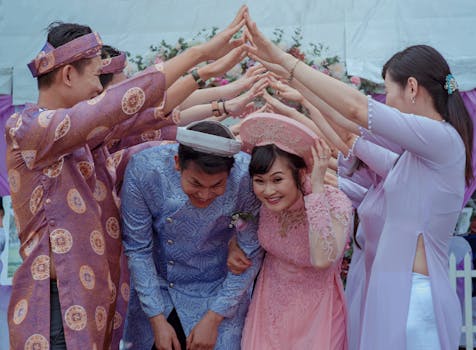Romanian Folk Costumes: Traditions and Elegance at the Wedding
Romania, a country rich in history and culture, boasts a vibrant tapestry of traditions, particularly evident in its folk costumes. These garments are not merely clothing; they are a reflection of the Romanian identity, embodying the values, beliefs, and artistry of the people. Among the various occasions where these costumes shine, weddings stand out as a significant celebration where tradition meets elegance.
The Significance of Folk Costumes in Romanian Weddings
Folk costumes play a crucial role in Romanian weddings, symbolizing the union of two families and the continuation of cultural heritage. Each region in Romania has its unique style of folk costume, which is often worn during wedding ceremonies. These costumes are characterized by intricate designs, vibrant colors, and the use of natural materials, showcasing the craftsmanship of local artisans.
Regional Variations
Romania’s diverse geography has led to a variety of folk costumes, each with distinct features. Here are some notable regional styles:
- Transylvanian Costumes: Known for their elaborate embroidery and use of wool, these costumes often feature dark colors with bright floral patterns.
- Moldavian Costumes: Characterized by their white base and colorful sashes, Moldavian costumes often include intricate lacework and are adorned with traditional motifs.
- Oltenian Costumes: These costumes are typically more straightforward, featuring bold colors and geometric patterns, reflecting the simplicity of rural life.
Elements of Elegance in Folk Costumes
The elegance of Romanian folk costumes lies in their intricate details and the stories they tell. Each element of the costume has a purpose and significance:
- Embroidery: Hand-stitched patterns often represent local flora and fauna, as well as symbols of fertility and prosperity.
- Materials: Traditional costumes are made from natural fibers such as cotton, linen, and wool, which not only provide comfort but also durability.
- Accessories: Items like the “batic” (headscarf) for women and the “caciula” (hat) for men are essential components that complete the look and add to the cultural richness.
Weddings: A Showcase of Cultural Heritage
Weddings in Romania are grand affairs, often lasting several days and involving numerous rituals. The attire worn during these celebrations is a testament to the couple’s heritage and family traditions. Here’s how folk costumes are integrated into the wedding festivities:
- Pre-Wedding Rituals: During events like the “logodna” (engagement), families often wear traditional costumes to honor their ancestry.
- Ceremony Attire: The bride typically wears a white dress adorned with traditional embroidery, while the groom dons a white shirt and a vest, both reflecting their regional styles.
- Reception Celebrations: As the festivities continue, guests often change into folk costumes, creating a vibrant atmosphere filled with music and dance.
Case Studies: Modern Interpretations of Folk Costumes
In recent years, there has been a resurgence of interest in traditional Romanian folk costumes, particularly among younger generations. Many couples are choosing to incorporate these garments into their weddings, blending modern aesthetics with traditional elements. For instance:
- Designer Collaborations: Local designers are creating contemporary versions of folk costumes, making them more accessible and appealing to modern brides and grooms.
- Social Media Influence: Platforms like Instagram have allowed couples to showcase their unique wedding styles, inspiring others to embrace their cultural heritage.
Conclusion: Embracing Tradition with Elegance
Romanian folk costumes are more than just attire; they are a celebration of identity, history, and artistry. At weddings, these costumes serve as a bridge between the past and the present, allowing couples to honor their heritage while embracing modernity. As the interest in traditional garments continues to grow, it is clear that Romanian folk costumes will remain a vital part of the cultural landscape, ensuring that the elegance and traditions of these beautiful garments endure for generations to come.
